Apple Watch Series 4 Review
Apple Watch Series 4 is the best smartwatch we've ever used
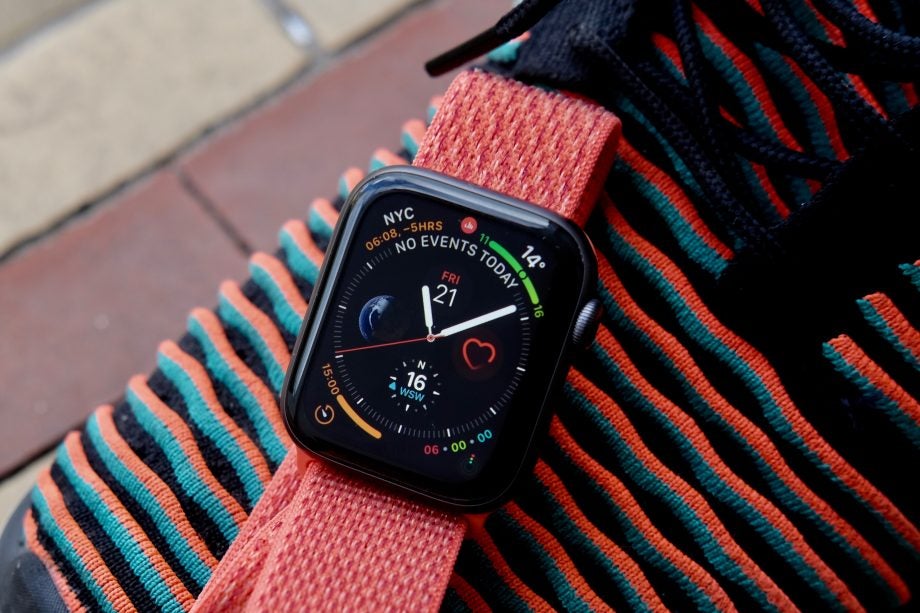

Verdict
The Apple Watch 4 is the best smartwatch I have ever used with a seriously rich feature list
Pros
- Feels great to wear
- Screen is gorgeous
- Huge amount of strap options
- Fantastic array of fitness and health features
- It motivates you so well to be active
Cons
- It won’t last multiple days without needing a charge
- Still won’t track sleep natively
- No always-on display is irritating
Key Specifications
- Review Price: £399
- Two sizes: 40 and 44mm
- OLED display
- 18-hour battery life
- ECG
- HRM
- WatchOS 5
What is it?
It has been a few months since the Apple Watch 4 was launched alongside the iPhone XS and iPhone XS Max and it remains the finest smartwatch I have ever used and reviewed. You also now benefit from the ECG app now being available in the UK.
With its slick design, vast amount of strap options and an utter boatload of features it’s no surprise the Apple Watch Series 4 remains our smartwatch of choice.
Related: Apple Watch 5 review
Design and straps
- The screen’s bezels have been minimised for a more immersive experience
- The rotating crown now responds with haptic feedback
- New 40mm model introduced in the Series 4 range
There’s been little change in the design of the Apple Watch since its introduction – until now. The Series 4 is the first real reinvention of the wearable. I say reinvention, but if you’re familiar with previous Apple Watches then you’ll instantly feel at home with the Apple Watch Series 4.
Unlike the majority of Wear OS wearables, the Apple Watch 4 retains the square display, having decided against making it circular. Personally, I prefer this – I often find circular smartwatches try too hard to mimic ‘proper’ mechanical watches and end up looking like cheap knock-offs. Then again, by keeping the squared-off look there is still a hint of ‘computer on your wrist’ about the Apple Watch that some might not like.
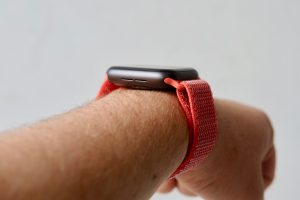
Instead of offering a radical redesign, Apple has tweaked everything that was there before. The screen now stretches almost to the edge of the face, reducing the bezel that flows around the sides. Imagine the difference between the iPhone 8 and iPhone X, and you’ll understand what Apple has done here. Pair this updated screen with the steeper, curvier corners and you’ve got a watch that really feels all-screen. I switched back to an Apple Watch Series 3 midway through this review and the difference is really remarkable. The older wearable feels noticeably cramped and old-fashioned in comparison.
This is also the first Apple Watch to play about with the sizing, replacing the 38mm and 42mm sizes with 40mm and 44mm. I was initially sceptical about the 44mm size (this is one I have been using during the review period) as there were times when I felt the 42mm size was a little on the large side for my wrists, but really the difference is negligible and just leads to bigger displays.
The new 40mm version has a screen size comparable to the older 42mm watch, but with a display that’s more akin to the 42mm one. The 44mm, on the other hand, is only slightly larger than the 42mm model. If you have larger wrists then the 44mm is the way to go – the larger screen is great for cramming more information and making it easier to see. However, if your wrists are on the smaller side then you’re not losing too much by plumping for the smaller size.
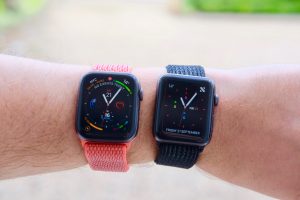
Apple Watch 4 (left) & Watch 3 (right)
A subtler design change is that the sensor array that sits on the bottom of the watch has been shrunken down, resulting in a less bulbous look. This means the Apple Watch 4 sits closer to the wrist than before. It’s a small design tweak – one you’ll only notice if you’re upgrading from a previous model – yet it’s something I have constantly been impressed with.
Related: Best smartwatch
Flanking the improved screen are the usual selection of buttons: the Digital Crown for navigation and a secondary, side button. The Digital Crown now has haptic responses when you twist it, slightly bumping your finger with a subtle vibration. As with so many design tweaks here, it seems small at first but the result is terrific. The resistance offered when you’re scrolling through menus, or jumping between options in the Workout app, adds that tangible feeling so often missing from techy watches.
Below the Digital Crown is the side button that’s been re-appropriated in use over the years. It can now either bring up your dock of favourite apps or your most recently used apps. I mainly use it for bringing up Apple Pay.
Inbetween the Digital Crown and side button is the microphone, while the speaker has been shunted to the other side. This is to try and avoid any interference between the two.
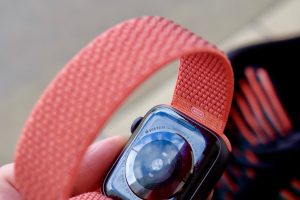
Even though Apple has altered the sizing, older straps and bands (Apple’s own or third-party) will still work just fine. This is massive news and very un-Apple. I’ve picked up loads of straps both from Apple and from the large selection on Amazon over the past few years and it’s nice to know the investment is still valid.
Throughout the majority of the review I have been switching between the Sport Loop and the Sport Strap, with the Leather Loop thrown in for the classier occasion. The ease of the Sport Loop, with its velcro band, is my favourite of the bunch – it’s just the easiest and the comfiest. It’s made from a slightly elastic fabric and uses a hook and loop fixing, similar to the premium Milanese Loop, to secure around your wrist. Since it uses this strap, it’ll fit pretty much any sized wrist and allow you to alter the fit depending on what you’re doing.
All models of the Apple Watch Series 4 remain water-resistant to 50m and will survive a dunk in sea water, too. These models use the same water-ejection method as the Series 2 and Series 3, where it will play a specific tone to eject water from the speaker.
Screen and speaker
- The Series 4 has a larger screen that goes right to the edges
- The included OLED panel is bright and easy to read
- The lack of an always-on display holds the Series 4 back
The display is real the star of the show here, and for some it might be reason enough to upgrade. If you plump for the 44mm model there’s a 368 x 448 display, with the 40mm packing 324 x 394 pixels. This is the only difference between the two.
Both use OLED display types, offer Force Touch and 1000 nits of brightness. Other watches, notably the Fitbit Versa and its cheaper sibling the Fitbit Versa Lite, match this peak brightness and it’s vital for ensuring you can comfortably read whatever’s on the watch even if you’re running in intense sunlight. The touchscreen remains incredibly vibrant and sharp, whether displaying one of the new Apple Watch 4 exclusive watch faces or your fitness stats for the day. The font is readable and icons are easy to see and interact with.
Having a larger panel means Apple can cram more information into the watch faces it includes. There are two headline faces exclusive to the Series 4 and they both let you add many more complications than were previously available. I’ve mainly been sticking with the Infograph option, which allows for an impressive eight complications, but there’s a digital-focused Infograph modular option too.
Related: Best smartphones
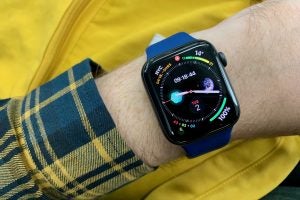
Infograph watch face allows for eight complications
Having so many nuggets of information available at a glance could have been overwhelming, however the bright and varied use of colour helps each stand out. If you’re a previous Apple Watch user then you’ll notice only updated complications work with these new faces and even Apple hasn’t altered many of its old ones. This means you might be switching back to some of the old ones if you’ve got a particular set-up you favour.
If you really want to show off the new display then there’s the Vapor and Fire/Water watch faces that highlight the edge-to-edge nature of the panel. The highlight of these is the fire option, which sees a roaring flame explode out of the dial. The functionality of these is limited though, as you can’t add any complications without sacrificing the full-screen look.
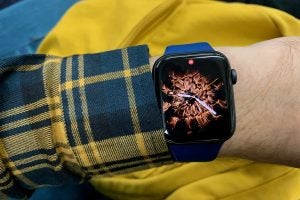
The new fire watch face explodes from the dial
I still have a big complaint, though, and it’s the same complaint Richard Easton levelled at the Series 3 – why is there no always-on display option so I can constantly see the time? This is something just about every other high-end smartwatch we’ve reviewed this year has implemented and it’s sorely missing here. I understand this would heavily impact battery life and Apple wants to ensure everyone’s watch makes it through the day, but there’s nothing wrong with giving consumers the choice.
A quick rising of your wrist brings the screen to life and this ensures every time you look at the watch the time is visible. I’d even say the Apple Watch Series 4 jumps into life faster than its predecessor. You can also more discreetly view the time by rotating the digital crown when the display is off. This turns the display on gradually, upping the brightness little by little.
The speaker now resides on the left-hand side of the watch, moved away from the microphone to ensure there’s no interference between the two. The speaker itself is loud, ridiculously so for something this small. It’s a shame, then, that you can’t really use it for much. It’s main function is to relay Siri answer and queries back to you – something it handles well – but I’d like to always use it for, say, listening to a podcast while i’m home.
WatchOS 5 and performance
- Podcasts are now readily available through a dedicated app
- The included S4 chipset does a decent job of keeping things snappy
- Siri and the process of loading non-local apps needs improving
Released alongside the Apple Watch 4, watchOS 5 brings a handful of software updates and tweaks to all the previous Apple Watch models (aside from the very first version, often dubbed Series 0).
There’s no headline-grabbing feature in watchOS 5; instead it’s a mixture of bug fixes and smaller features. There’s now a Podcast app, for example, which is ideal if you want to leave your phone at home while you go to the gym, and a new Walkie-Talkie feature that sends short audio messages to friends. You can also track your Yoga workouts.
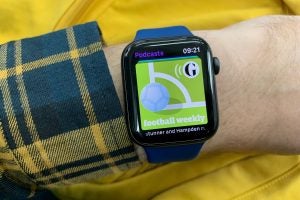
You can play podcasts from the Apple Watch
WatchOS includes a number of typical smartwatch features, too. Notifications pop up from a linked iPhone (Apple Watch supports any iPhone from the 5S) and can be acted upon either with canned responses or something more personal if it’s an app like iMessage. There are also apps for Maps, Email, Alarms and plenty more.
Powering the Apple Watch Series 4 is the S4 chip; the first Watch 64-bit SoC (system on a chip) used by Apple. It claims it’s 2x faster than the S3, however testing these claims on a device like this is tricky.
This is a snappy watch, though, and one that jumps between faces, open apps and workout options quickly. You’ll still have to wait an age to open an app that isn’t stored in memory, but with the dwindling reliance on actual apps in the watchOS ecosystem it’s a problem I have rarely struggled with.
The improved performance also helps Siri react faster, and considering the slightly dodgy voice-assistant is still a big play here, that’s a bonus. Siri can be initiated by either holding down the Digital Crown or raising the watch and saying, “Ok, Siri.”
Siri is far from perfect and a feature I rarely use on my iPhone, yet on the watch it’s arguably more useful. Asking it to start a timer when my hands are sticky with bread dough is ridiculously useful, and it’s good to know I’ll always be reminded when the timer hits zero even if I leave my phone in another room. Siri is also great for quick measurement calculations and weather checks.
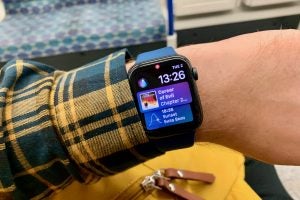
This is the Siri watch face
Siri’s skills are also built into its own watch face. The Siri face debuted on WatchOS 4 and has received a boost this time around with some ‘machine learning’ skills. Supposedly it’s meant to throw things like music playlists and directions into the stream of cards, but i’ve found it’s still rather useless. Unless you like your watch being taken over by a random picture you took last year, that is.
Apple Watch Series 4 comes in two variations: one with GPS, and another with GPS and LTE. I’ve been using the LTE model for this review and picking this connected option will add an extra £/$100 to the price if you plump for the aluminium watch. It comes as standard on the stainless steel versions.
Honestly, if I was buying this watch for myself I wouldn’t pay the extra for LTE. That comes down in part to the poor support it has received from UK carriers – it’s currently only supported by EE and Vodafone – and the fact it’ll add an extra £5 to your monthly bill. It’s also fairly limited and is mainly used only for taking/giving calls and replying to iMessages.
Still, the actual way the LTE/4G functionality works is slick. Signal strength is reliable and those who I rang on the watch couldn’t notice any difference between it and a phone call.
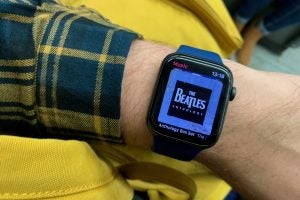
You can play Apple Music directly from the watch
Another benefit of having an LTE/4G connection is music streaming directly to the watch. This is limited to Apple Music (sorry Spotify users) and is a fantastic gym addition – letting you leave your phone in the locker and remain connected to an entire music library. Tunes can also be directly stored on the device and there’s 16GB available space to play with here. Syncing songs across, however, can be a fiddly and ridiculously time-consuming process, and it’s something best left to work overnight.
Health and fitness tracking
- The new ECG sensor can be a live saver under the right circumstances
- Fall detection is a great addition (even if it is hard to test)
- Apple’s ring system is still great for understanding your effort
After the disappointing original Apple Watch, Apple focused more with the successor, positioning it as an accessory for tracking runs, gym sessions and swims.
The Apple Watch 4 keeps all the fitness-tracking features, but diversifies slightly to add a more health-tracking aspect too. This is where the device moves from expensive gadget to potential lifesaver.
However, it’s hard to test out these new health-focused features. Fall detection is one of the big new additions here and it works thanks to the new, more accurate accelerometer sensors inside the body. In theory, fall detection will alert you when you fall, slip or trip over; sending out an alert to emergency services and a selection of pre-selected contacts if you don’t move for a certain period of time after the fall.
Related: Best running watches
It’s a tremendous idea and one that could save someone’s life. It’s not, however, something that can be triggered by pretending to fall or even being pushed over. Trust me, I’ve tried.
This feature isn’t being aimed at me though; that’s made clear by the fact it’s turned off by default for anyone under 65. As someone who knows the problems accidental falls can cause, this feature alone would instantly make me want to recommend this to older relatives. That’s not something I would have said about a mass-market smartwatch before.
Another huge health benefit of the Apple Watch Series 4 is the electrocardiogram sensor. This sensor will be able to take an ECG, feed you back the results and allow them to be shared with your doctor. The ECG app can tell you if your heart shows signs of atrial fibrillation, a serious form of irregular heartbeat rhythm, or sinus rhythm – a normal beating. This ECG app will only work in the UK and US for now. Hopefully we’ll see it in other territories in the future.
Health might be the focus here, but the Apple Watch Series 4 remains an excellent wearable for both keeping an eye on your daily movements and deeper tracking of gym-focused workouts, swimming and yoga. The watch is packed with pretty much every sensor you’ll need: GPS, altimeter, improved accelerometer, optical/electric heart rate monitor and an ambient light sensor.
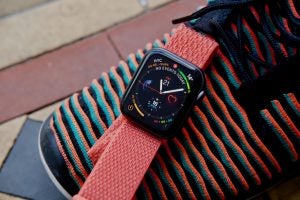
The first of the two fitness-focused apps on the Apple Watch Series 4 is Activity. This is, in my opinion, the finest and most encouraging step-tracking app on any wearable you can buy today. If you’re coming from an older Apple Watch though, you won’t notice anything different here.
The basis of this Activity app is three rings, each of which you’re encouraged to fill up during the day. One is Movement, another Exercise and the final, Stand. When you first set-up the Apple Watch you’ll be prompted to enter some basic details – gender, height, weight etc – and then it’ll give you suggested targets for each, You can, of course, alter these manually afterwards. As an example, I selected 800 calories burned in movement, 30 minutes exercise and to stand at least once every hour throughout the day. There’s still no way to include flights of stairs climbed as part of your daily goal, something Richard Easton requested in his Apple Watch 3 review.
The ring-based visual is a great way to ensure you’re always looking at your activity, helping to motivate you to fill the rings. For instance, you’ll get a buzz on the wrist if you haven’t stood up for a while, or a quick suggestion that a ‘brisk 15-minute walk’ would fill up your movement ring for the day. It’s encouraging, without being patronising or simply asking you to take 10,000 steps.
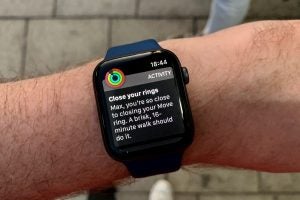
Achievements are available if you hit certain targets and you can share and compete with others if you need to add some extra spice.
The workout app is the place to go for more specific tracking, particular if you want to track a run, swim, cycle or round of HIIT training.
The onboard GPS (a feature included on the LTE and non-LTE models) means you don’t have to rely on a connected phone – like you’d have to do with the Fitbit Versa or Withings Sport HR – and the results were very accurate during my testing. As not much of a runner, I tended to stick to shorter runs during the review process but the data it captured matched the distances I was travelling.
Being able to stream music directly to the watch and take any incoming calls means you can head out for a 10km run with just your watch and some AirPods. When you’re running you’ll also get heart rate data – again this data was comparable to both the older Apple Watch 3 and a Fitbit Charge 2 I was using as a comparison.
If your heart rate rises above a certain level (120bpm) a warning will be triggered on the watch. The same will happen if your heart rate drops below a certain level or becomes irregular. Like the ECG, you’ll have to wait until an update later in the year to make use of low heart rate warnings.
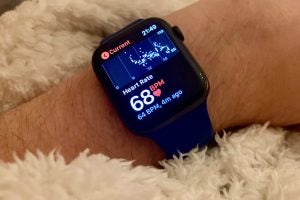
Heart rate is tracked over the day
I’m more at home in the pool, and the Apple Watch 4 is great for swimmers. You choose from either a pool or open water swim and after selecting the length it’ll keep you updated on lengths swam and calories burned. Once you’re finished, it’ll combine everything into an easy-to-digest overview of your swim. WatchOS 5 also includes automatic activity tracking, so if you forget to initiate a workout the likelihood is that the watch will know.
Another appreciated trick, and something Fitbit is enabling for the Charge 3, is being able to set targets for your workouts. You can set it so your swim lasts until you’ve burned through a certain amount of calories, or have run for a certain distance.
There’s still no native sleep tracking on the Apple Watch 4, so you’ll be once again using a third-party alternative to monitor your slumber. I’d guess Apple keeps leaving this out because of the ‘all-day’ battery claim and the fact it assumes you’ll be charging the watch at night. When we get a device Apple can comfortably say will last multiple days, that is when I think sleep tracking will be introduced.
Related: Best fitness trackers
As someone who would never wear a full-on running and rarely tracks runs or swims, having the Apple Watch 4 on is a constant stream of encouragement and actively makes me want to keep an eye on how much exercise I do. Workouts are easy to start and the information churned out is genuinely useful, which makes me want to keep on filling my rings each and every day.
Battery life
- Expect to get a day’s use out of the Series 4
- Daily charging is required to make the most of the Apple Watch
- A full charge can be reached in just under two hours
Battery life is one of the few areas of the Apple Watch Series 4 that hasn’t received a huge update. Apple makes the same ‘all-day, 18 hours of usage’ claim it made for the Series 3 and during my time with the watch it has met, and often exceeded, that.
Apple’s vision of this watch is clearly something you wear during the day and plonk on the magnetic charger at night. That’s fine by me, even though I would appreciate it eventually becoming a multi-day wearable.
How long the Apple Watch Series 4 lasts hangs significantly on your usage. On the days that it was purely tracking my movement, telling me the time, playing podcasts and alerting me to notifications, it would end the day at 35-40%, leaving enough spare juice had I forgot to charge it. There were even a few occasions where I would make it through two days without having to enable the power-saving mode. When it does drop below a certain percentage of remaining juice, the watch switches to a much simpler mode where the time is only displayed when you press one of the buttons.
The days when I was utilising the GPS for workout tracking or LTE for phone-calling had a much more obvious effect on the battery. This is to be expected, of course. Still, the results I achieved were good.

The charger plus onto the back of the Apple Watch 4
Running for an hour – with GPS, LTE and AirPods connected via Bluetooth – the Apple Watch Series 4 lost between 17-23%. Disconnect the AirPods and remove the LTE functionality and you’ll save about 6-8%. Obviously these times vary depending on how often you check the watch and if you receive/take calls during that period.
LTE calling depletes the battery faster than hammering the GPS. This reaffirms the point that this is purely meant as an addition to your phone, rather than a futuristic wrist-based replacement for it.
Charging is reasonably quick and requires about 45 minutes to reach 50% and marginally less than two hours to get all the way to 100%, The charger itself remains a small magnetic puck, which clips onto the bottom of the watch. The magnets are strong and it’s not easy to accidentally knock the watch off once it’s in place.
It is quite annoying having to always the remember the proprietary Apple Watch charger though and it feels like Apple should have, by now, come up with a simpler solution. AirPower – a charging mate that’d juice up AirPods, iPhones and Apple Watch simultaneously – seemed like the solution, but has yet to materialise.
Why buy the Apple Watch 4?
Apple Watch Series 4 is not only the most impressive Apple Watch yet, but is comfortably the most fully featured smartwatch I have ever tested. It’s Apple’s best, most thought-out release in years.
It’s a masterful combination of design; genuinely useful features and an impressive ecosystem. Apple’s ability to push categories like phones and laptop forward has diminished over recent years, but this wearable is so far ahead of competitors such as the Samsung Galaxy Watch and Wear OS releases from Fossil that it almost seems unfair.
Pair the updated design featuring that gorgeous screen with the vast array of (potentially) life-saving features and you’ve finally got a smartwatch that feels like something other than a luxury device missing a point.
Nothing is perfect though, and I would still like to see an Apple Watch that tracks my sleep natively and doesn’t require plugging in at least every other night. But they’re just minor quibbles in the grand scheme of things.
Verdict
The Apple Watch 4 is the best smartwatch I have ever used.
FAQs
The Apple Watch 4 is water resistant to a range of 50m and can be worn in a pool or the ocean.
It is not locked to a carrier, however only certain carriers support the cellular functionality
Yes, you get a wireless charger with the Apple Watch 4.
Specs
Jargon buster
BPM
An abbreviation of ‘beats per minute’, used to describe the pace of someone’s heartbeat as recorded by a smartwatch or some other wearable.
HRM
An abbreviation of ‘heart rate monitor’, used to describe a device that can track the beats per minute of a user’s heart.
OLED and AMOLED
Types of displays that use self-lighting pixels to provide greater contrast and more vibrant colours than a typical LCD display, as well as sharper blacks.
IP rating
An abbreviation for ‘Ingress Protection Code’, which lets you know to what extent a device might be waterproof or dustproof.
watchOS
Apple’s smartwatch platform, exclusive to the Apple Watch series. The OS will only pair with Apple iPhones and there is no functionality for connecting with Android devices.
GPS
An abbreviation of the Global Positioning System, which uses satellite communication to pinpoint your location. Some smartwatches are able to achieve this communication without the use of a smartphone.


